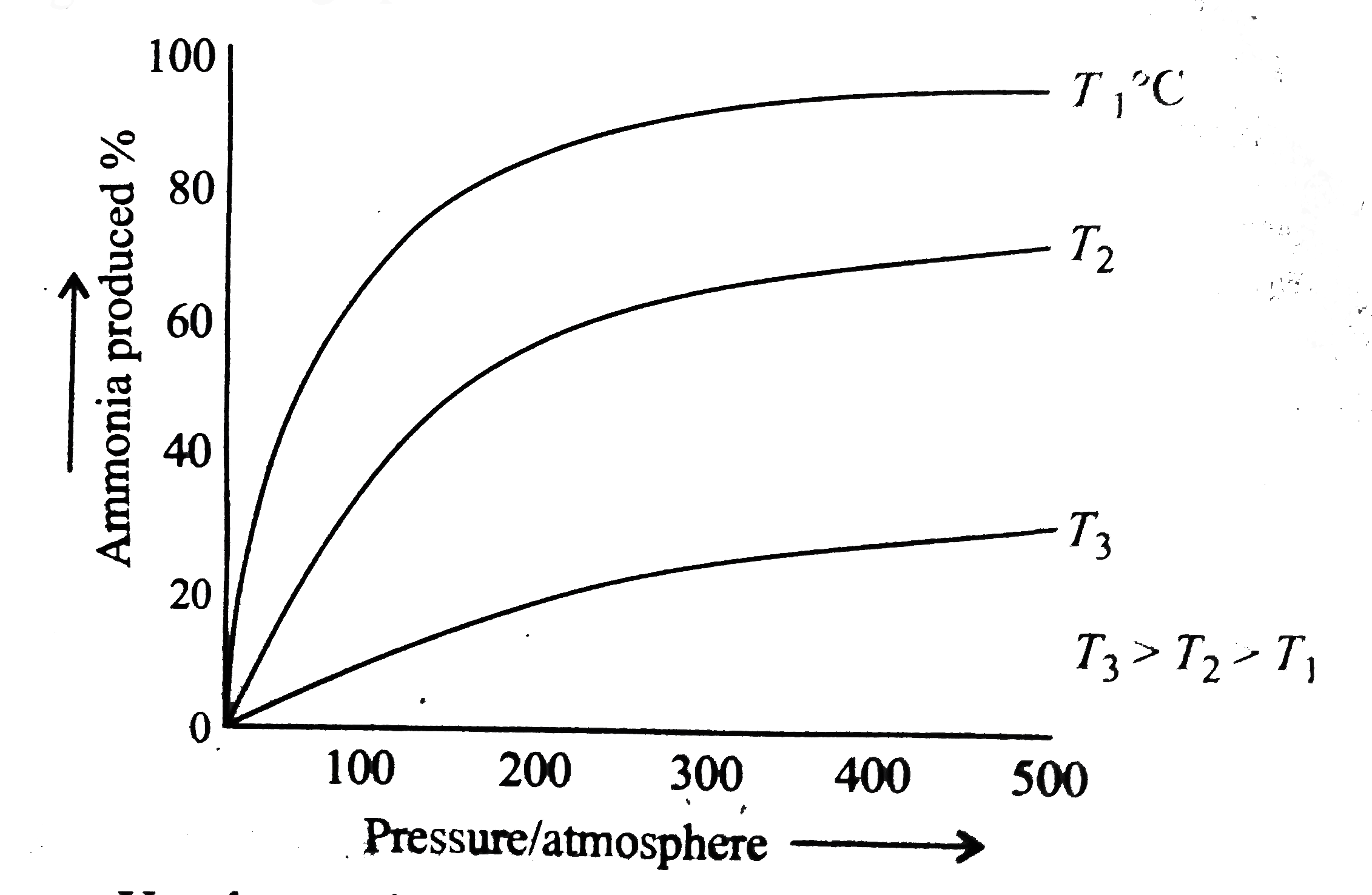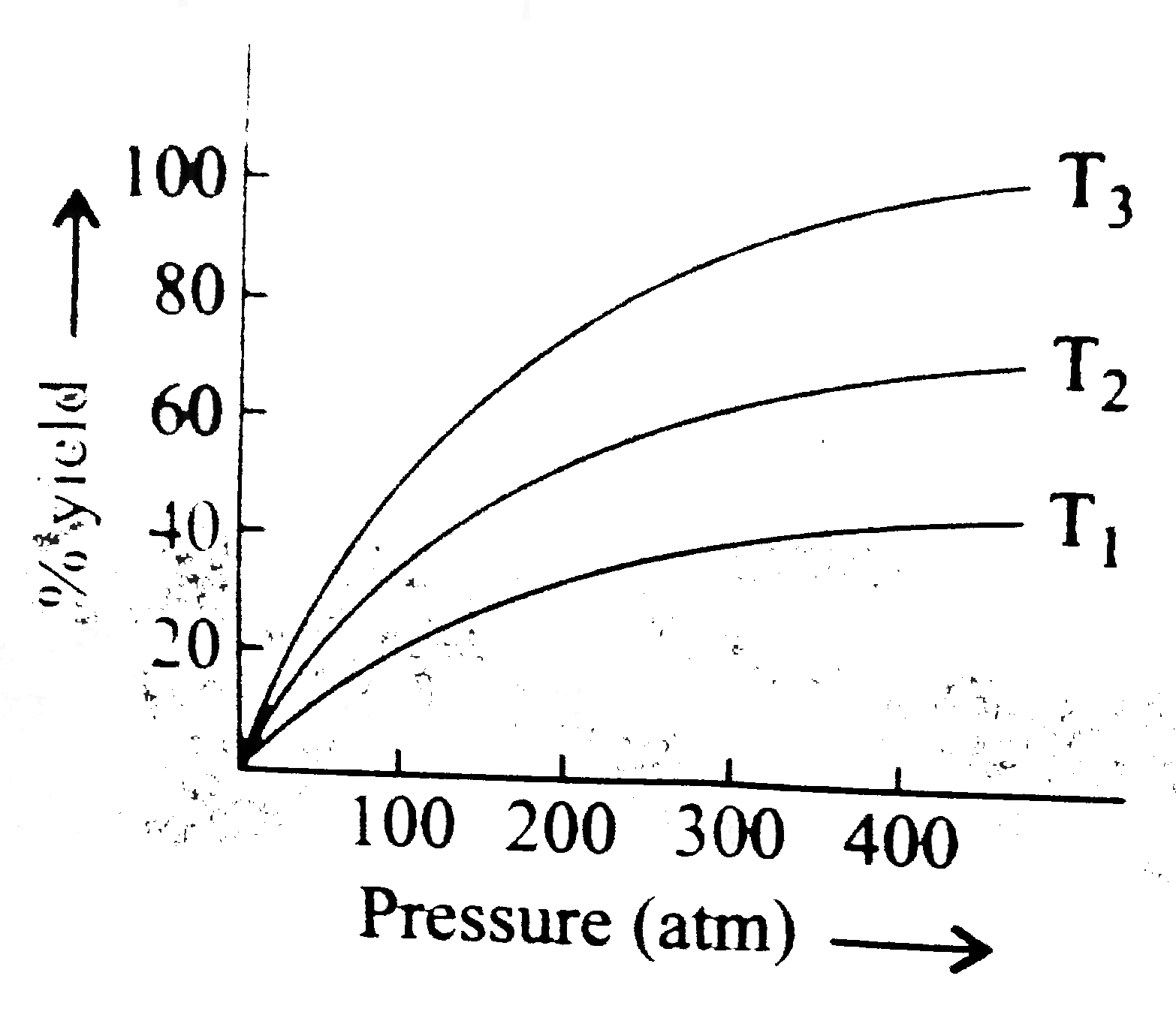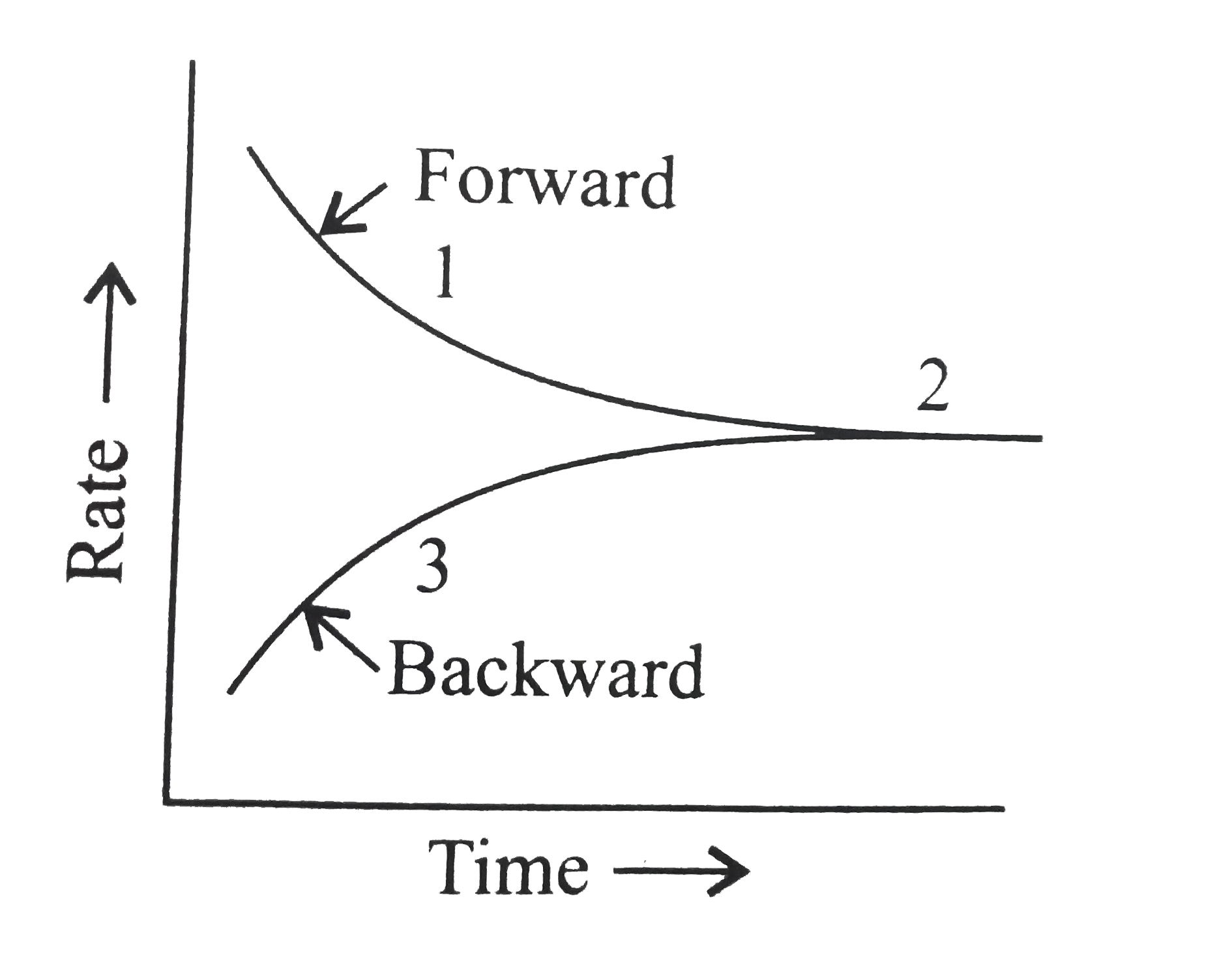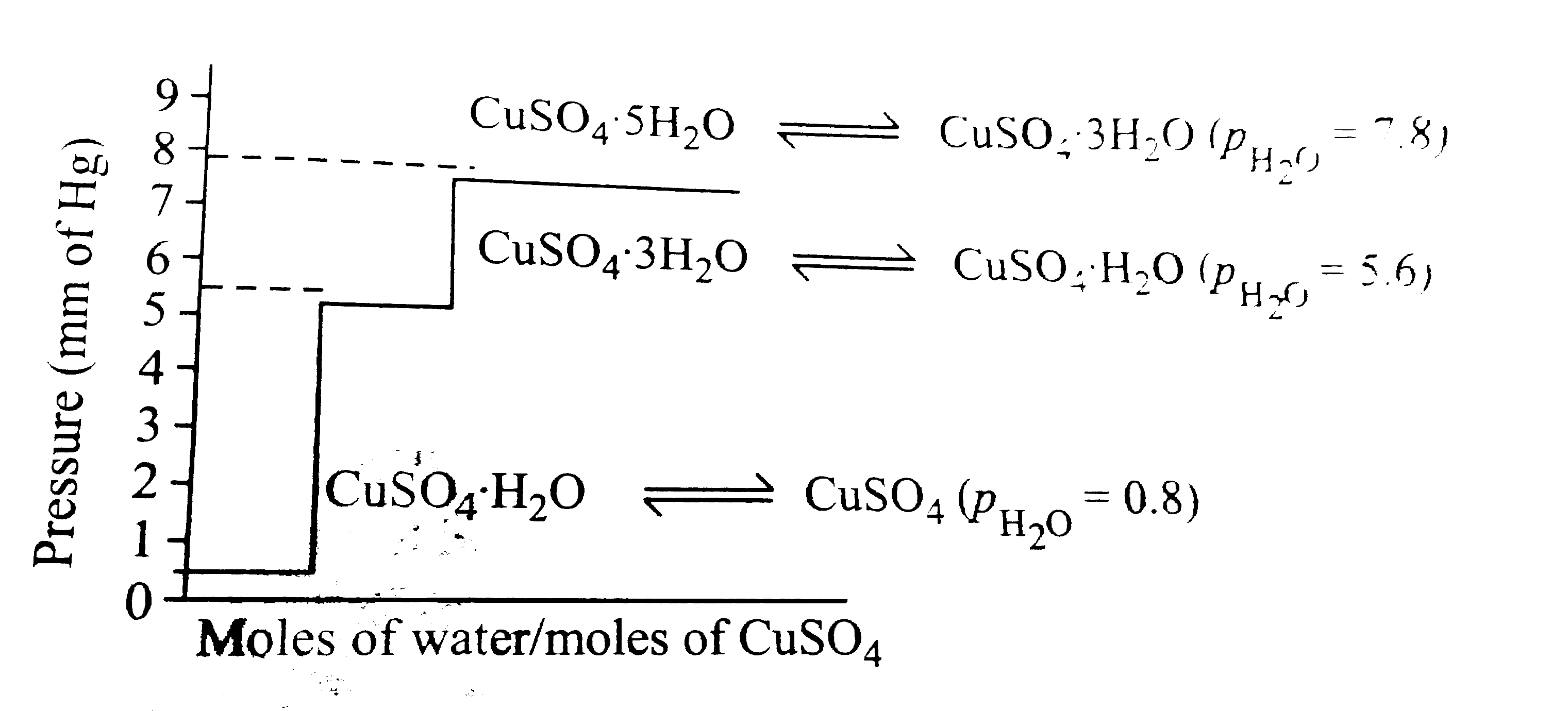Complete Solutions to Exercises (Linked Comprehensive) of chapter CHEMICAL EQUILIBRIUM of Class 11 book with complete answers and questions
| Class 11 | CHEMISTRY |
| Chapter | CHEMICAL EQUILIBRIUM |
| CENGAGE CHEMISTRY | Exercises (Linked Comprehensive) |
| Number Of Questions | 54 |
| Academic Year | 2023-24 |
Consider the following equilibrium:
`2NO_(2) +O_(2)hArr 2NO_(3), DeltaH=-ve`,
If `O_(2)` is added and volume of the reaction vessel is reduced, the equilibrium03:36View SolutionIf we add `SO_(4)^(2-)` ion to a saturated solution of `Ag_(2)SO_(4)`, it will result in a//an
02:11View SolutionPhysical and chemical equilibrium can respond to a change in their pressure, temperature, and concentration of reactants and products. To describe the change in the equilibrium we have a principle named Le Chatelier principle. According to this principle, even if we make some changes in equilibrium, then also the system even re-establishes the equilibrium by undoing the effect.
In the reaction `N_(2)(g)+3H_(2)(g) hArr 2NH_(3)(g)`. If we increase the pressure of the system, the equilibrium is02:08View SolutionConsider the chemical reaction:
`underset(("Green solution"))(Ni^(2+)(aq))+6NH_(3)(aq) hArr underset(("Blue solution"))([Ni(NH_(3))_(6)]^(2+)) (aq)`
When `H^(o+)(aq)` is added, the colour green is favoured. Use one or more of the following interpretations to answer the questions:
i. Some unreacted `Ni^(2+)(aq)` is present in the solution at equilibrium
ii. Some unreacted `NH_(3)(aq)` is present in the solution at equilibrium
iii. The colour change indicates new equilibrium conditions with reduced `[Ni(NH_(3))_(6)]^(2+)(aq)`
iv. The colour change indicates new equilibrium conditions with increased `[Ni(NH_(3))_(6)]^(2+)(aq)`.
The deepening of blue colour on dissolving more `Ni(NO_(3))_(2)` supports interpretation (s).05:14View SolutionConsider the chemical reaction:
`underset(("Green solution"))(Ni^(2+)(aq))+6NH_(3)(aq) hArr underset(("Blue solution"))([Ni(NH_(3))_(6)]^(2+)) (aq)`
When `H^(o+)(aq)` is added, the colour green is favoured. Use one or more of the following interpretations to answer the questions:
i. Some unreacted `Ni^(2+)(aq)` is present in the solution at equilibrium
ii. Some unreacted `NH_(3)(aq)` is present in the solution at equilibrium
iii. The colour change indicates new equilibrium conditions with reduced `[Ni(NH_(3))_(6)]^(2+)(aq)`
iv. The colour change indicates new equilibrium conditions with increased `[Ni(NH_(3))_(6)]^(2+)(aq)`.
The deepening of blue colour on addition of more `NH_(3)(aq)` supports interpretation(s).03:04View SolutionOne "mole" of `NH_(4)HS(s)` was allowed to decompose in a `1-L` container at `200^(@)C`. It decomposes reversibly to `NH_(3)(g)` and `H_(2)S(g). NH_(3)(g)` further undergoes decomposition to form `N_(2)(g)` and `H_(2)(g)`. Finally, when equilibrium was set up, the ratio between the number of moles of `NH_(3)(g)` and `H_(2)(g)` was found to be `3`.
`NH_(4)HS(s) hArr NH_(3)(g)+H_(2)S(g), K_(c)=8.91xx10^(-2) M^(2)`
`2NH_(3)(g) hArr N_(2)(g)+3H_(2)(g), K_(c)=3xx10^(-4) M^(2)`
Answer the following:
What is the "mole" fraction of hydrogen gas in the equilibrium mixture in the gas phase?08:31View SolutionOne "mole" of `NH_(4)HS(s)` was allowed to decompose in a `1-L` container at `200^(@)C`. It decomposes reversibly to `NH_(3)(g)` and `H_(2)S(g). NH_(3)(g)` further undergoes decomposition to form `N_(2)(g)` and `H_(2)(g)`. Finally, when equilibrium was set up, the ratio between the number of moles of `NH_(3)(g)` and `H_(2)(g)` was found to be `3`.
`NH_(4)HS(s) hArr NH_(3)(g)+H_(2)S(g), K_(c)=8.91xx10^(-2) M^(2)`
`2NH_(3)(g) hArr N_(2)(g)+3H_(2)(g), K_(c)=3xx10^(-4) M^(2)`
Answer the following:
To attain equilibrium, how much `%` by weight of folid `NH_(4)HS` got dissociated?05:31View SolutionOne "mole" of `NH_(4)HS(s)` was allowed to decompose in a `1-L` container at `200^(@)C`. It decomposes reversibly to `NH_(3)(g)` and `H_(2)S(g). NH_(3)(g)` further undergoes decomposition to form `N_(2)(g)` and `H_(2)(g)`. Finally, when equilibrium was set up, the ratio between the number of moles of `NH_(3)(g)` and `H_(2)(g)` was found to be `3`.
`NH_(4)HS(s) hArr NH_(3)(g)+H_(2)S(g), K_(c)=8.91xx10^(-2) M^(2)`
`2NH_(3)(g) hArr N_(2)(g)+3H_(2)(g), K_(c)=3xx10^(-4) M^(2)`
Answer the following:
What is the "mole" fraction of hydrogen gas in the equilibrium mixture in the gas phase?08:31View SolutionThe persentage of ammonia produced from nitrogen and hydrogen under conditions of temperature and pressure is given in the graph

Use the graph answering the following questions:
What happens to the percentage of ammonia produced when the temperature is increased01:59View SolutionThe persentage of ammonia produced from nitrogen and hydrogen under conditions of temperature and pressure is given in the graph

Use the graph answering the following questions:
What happens to the percentage of ammonia produced when the pressure is increased?01:38View SolutionThe persentage of ammonia produced from nitrogen and hydrogen under conditions of temperature and pressure is given in the graph

Use the graph answering the following questions:
What conditions of pressure produce the highest percentage of ammonia?01:53View SolutionThe synthesis of ammonia is given as:
`N_(2)(g)+3H_(2)(g) hArr 2NH_(3)(g), DeltaH^(ɵ)=-92.6 kJ mol^(-1)` given `K_(c)=1.2` and temperature `(T)=375^(@)C`
The expression of equilibrium constant is02:56View SolutionThe synthesis of ammonia is given as:
`N_(2)(g)+3H_(2)(g) hArr 2NH_(3)(g), DeltaH^(ɵ)=-92.6 kJ mol^(-1)` given `K_(c)=1.2` and temperature `(T)=375^(@)C`
On increasing the temperature, the value of equilibrium constant `K_(c)`01:44View SolutionThe synthesis of ammonia is given as:
`N_(2)(g)+3H_(2)(g) hArr 2NH_(3)(g), DeltaH^(ɵ)=-92.6 kJ mol^(-1)` given `K_(c)=1.2` and temperature `(T)=375^(@)C`
The relationship between `K_(p)` and `K_(c)` for this reaction is03:25View SolutionThe synthesis of ammonia is given as:
`N_(2)(g)+3H_(2)(g) hArr 2NH_(3)(g), DeltaH^(ɵ)=-92.6 kJ mol^(-1)` given `K_(c)=1.2` and temperature `(T)=375^(@)C`
Which of the following factors does not alter the yield of `NH_(3)` at equilibrium?02:43View SolutionThe synthesis of ammonia is given as:
`N_(2)(g)+3H_(2)(g) hArr 2NH_(3)(g), DeltaH^(ɵ)=-92.6 kJ mol^(-1)` given `K_(c)=1.2` and temperature `(T)=375^(@)C`
Starting with `2` mol of each `(N_(2), H_(2) "and" NH_(3))` in `5.0 L` reaction vessel at `375^(@)C`, predict what is true for the reaction?03:58View SolutionPhosphorous pentachloride when heated in a sealed tube at `700 K` it undergoes decomposition as
`PCl_(5)(g) hArr PCl_(3)(g)+Cl_(2)(g), K_(p)=38` atm
Vapour density of the mixture is `74.25`.
The reaction is01:52View SolutionPhosphorous pentachloride when heated in a sealed tube at `700 K` it undergoes decomposition as
`PCl_(5)(g) hArr PCl_(3)(g)+Cl_(2)(g), K_(p)=38` atm
Vapour density of the mixture is `74.25`.
Percentage dissociation of `PCl_(5)` may be given as05:05View SolutionPhosphorous pentachloride when heated in a sealed tube at `700 K` it undergoes decomposition as
`PCl_(5)(g) hArr PCl_(3)(g)+Cl_(2)(g), K_(p)=38` atm
Vapour density of the mixture is `74.25`.
Equilibrium constant `K_(c)` for the reaction will be01:49View SolutionPhosphorous pentachloride when heated in a sealed tube at `700 K` it undergoes decomposition as
`PCl_(5)(g) hArr PCl_(3)(g)+Cl_(2)(g), K_(p)=38` atm
Vapour density of the mixture is `74.25`.
If pressure is increased then the equilibrium will03:58View SolutionPhosphorous pentachloride when heated in a sealed tube at `700 K` it undergoes decomposition as
`PCl_(5)(g) hArr PCl_(3)(g)+Cl_(2)(g), K_(p)=38` atm
Vapour density of the mixture is `74.25`.
When an inert gas is added to the given reversible process, then the equilibrium will.03:27View SolutionDecomposition of ammonium chloride is an endothermic reaction. The equilibrium may be represented as:
`NH_(4)Cl(s) hArr NH_(3)(g)+HCl(g)`
A `6.250 g` sample of `NH_(4)Cl` os placed in an evaculated `4.0 L` container at `27^(@)C`. After equilibrium the total pressure inside the container is `0.820` bar and some solid remains in the container. Answer the followings
The value of `K_(p)` for the reaction at `300 K` is03:02View SolutionDecomposition of ammonium chloride is an endothermic reaction. The equilibrium may be represented as:
`NH_(4)Cl(s) hArr NH_(3)(g)+HCl(g)`
A `6.250 g` sample of `NH_(4)Cl` os placed in an evaculated `4.0 L` container at `27^(@)C`. After equilibrium the total pressure inside the container is `0.820` bar and some solid remains in the container. Answer the followings
The amount of solid `NH_(4)Cl` left behind in the container at equilibrium is04:24View SolutionDecomposition of ammonium chloride is an endothermic reaction. The equilibrium may be represented as:
`NH_(4)Cl(s) hArr NH_(3)(g)+HCl(g)`
A `6.250 g` sample of `NH_(4)Cl` os placed in an evaculated `4.0 L` container at `27^(@)C`. After equilibrium the total pressure inside the container is `0.820` bar and some solid remains in the container. Answer the followings
If the volume of container were doubled at constant temperature, then what would happen to the amount of solid in the container.03:13View SolutionDecomposition of ammonium chloride is an endothermic reaction. The equilibrium may be represented as:
`NH_(4)Cl(s) hArr NH_(3)(g)+HCl(g)`
A `6.250 g` sample of `NH_(4)Cl` os placed in an evaculated `4.0 L` container at `27^(@)C`. After equilibrium the total pressure inside the container is `0.820` bar and some solid remains in the container. Answer the followings
The value of `K_(p)` for the reaction at `300 K` is03:02View SolutionDecomposition of ammonium chloride is an endothermic reaction. The equilibrium may be represented as:
`NH_(4)Cl(s) hArr NH_(3)(g)+HCl(g)`
A `6.250 g` sample of `NH_(4)Cl` os placed in an evaculated `4.0 L` container at `27^(@)C`. After equilibrium the total pressure inside the container is `0.820` bar and some solid remains in the container. Answer the followings
The value of `K_(p)` for the reaction at `300 K` is03:02View Solution`K_(p)` and `K_(c)` are inter related as
`K_(p)=K_(c)(RT)^(Deltan)`
Answer the following questions:
Which of the following have `K_(p)=K_(c)`?05:36View Solution`K_(p)` and `K_(c)` are inter related as
`K_(p)=K_(c)(RT)^(Deltan)`
Answer the following questions:
Which of the following have same units of`K_(p)` ?06:08View Solution`K_(p)` and `K_(c)` are inter related as
`K_(p)=K_(c)(RT)^(Deltan)`
Answer the following questions:
In which of the following equilibria `K_(p)` is less than `K_(c)`?05:34View Solution`K_(p)` and `K_(c)` are inter related as
`K_(p)=K_(c)(RT)^(Deltan)`
Answer the following questions:
For `N_(2)(g)+3H_(2)(g) hArr 2NH_(3)(g), K_(p)//K_(c)` is equal to:03:19View Solution`K_(p)` and `K_(c)` are inter related as
`K_(p)=K_(c)(RT)^(Deltan)`
Answer the following questions:
The unit of equilibrium constant for
`H_(2)(g)+I_(2)(g) hArr 2HI(g)`01:40View SolutionConsider the following reactions:
i. `CO(g)+H_(2)O(g) hArr CO_(2)(g)+H_(2)(g), K_(1)`
ii. `CH_(4)(g)+H_(2)O(g) hArr CO(g)+3H_(2)(g), K_(2)`
iii. `CH_(4)(g)+2H_(2)O(g) hArr CO_(2)(g)+4H_(2)(g), K_(3)`
Which of the following is/are incorrect?03:19View SolutionThe equilibrium constant of the following reactions at `400 K` are given:
`2H_(2)O(g) hArr 2H_(2)(g)+O_(2)(g), K_(1)=3.0xx10^(-13)`
`2CO_(2)(g) hArr 2CO(g)+O_(2)(g), K_(2)=2xx10^(-12)`
Then, the equilibrium constant K for the reaction
`H_(2)(g)+CO_(2)(g) hArr CO(g)+H_(2)O(g)`
is03:07View SolutionThe relation between `K_(p)` and `K_(c)` is `K_(p)=K_(c)(RT)^(Deltan)` unit of `K_(p)=(atm)^(Deltan)`, unit of `K_(c)=(mol L^(-1))^(Deltan)`
Given: `2NO(g)+O_(2)(g) hArr 2NO_(2)(g), K_(1)`
`2NO_(2)(g) hArr N_(2)O_(4)(g), K_(2)`
`2NO(g)+O_(2)(g) hArr N_(2)O_(4)(g), K_(3)`
Which of the following relations is correct?04:43View SolutionThe relation between `K_(p)` and `K_(c)` is `K_(p)=K_(c)(RT)^(Deltan)` unit of `K_(p)=(atm)^(Deltan)`, unit of `K_(c)=(mol L^(-1))^(Deltan)`
`H_(3)ClO_(4)` is a tribasic acid, it undergoes ionisation as
`H_(3)ClO_(4) hArr H^(o+)+H_(2)ClO_(4)^(-), K_(1)`
`H_(2)ClO_(4)^(-) hArr H^(o+)+HClO_(4)^(2-), K_(2)`
`HClO_(4)^(2-) hArr H^(o+)+ClO_(4)^(3-), K_(3)`
Then, equilibrium constant for the following reaction will be:
`H_(3)ClO_(4) hArr 3H^(o+)+ClO_(4)^(3-)`02:31View SolutionIf `K_1` and `K_2` are the respective equilibrium constants for the two reactions
`XeF_6(g)+2HF(g)hArrXeOF_4(g)+2HF(g)`
`XeO_4(g)+XeFe_6(g)hArrXeOF_4(g)+XeO_3(g)`
The equilibrium constant of the reaction, `XeO_4(g)+2HF(g)hArrXeO_3F_2(g)+H_2O(g)` will be05:14View Solution`N_(2)(g)+3H_(2)(g) hArr 2NH_(3)(g), DeltaH^(ɵ)=-22.4 kJ`
The pressure inside the chamber is `100` atm and temperature at `300 K`
If `K_(p)` for the given reaction is `1.44xx10^(-5)`, then the value of `K_(c)` will be:02:51View Solution`N_(2)(g)+3H_(2)(g) hArr 2NH_(3)(g), DeltaH^(ɵ)=-22.4 kJ`
The pressure inside the chamber is `100` atm and temperature at `300 K`
The preparation of ammonia by Haber's process is an exothermic reaction. If the preparation follows the following temperature-pressure relationship for its `%` yield. Then for temperature `T_(1), T_(2)` and `T_(3)` the correct option is:
 02:21View Solution
02:21View Solution`N_(2)(g)+3H_(2)(g) hArr 2NH_(3)(g), DeltaH^(ɵ)=-22.4 kJ`
The pressure inside the chamber is `100` atm and temperature at `300 K`
On adding catalyst the equilibrium of reaction:02:15View Solution`N_(2)(g)+3H_(2)(g) hArr 2NH_(3)(g), DeltaH^(ɵ)=-22.4 kJ`
The pressure inside the chamber is `100` atm and temperature at `300 K`
If `K_(p)` for the reaction is `1.44xx10^(-5)`, then the value of `K_(p)` for the decomposition of `NH_(3)`
`2NH_(3)(g) hArr N_(2)(g)+3H_(2)(g)`
will be:02:48View SolutionMass action rato or reaction quotient Q for a reaction can be calculate using the law of masss action
`A(g)+B(g) hArr C(g)+D(g)`
`Q=([C][D])/([A][B])`
The value of Q decides whether the reaction is at equilibrium or not.
At equilibrium, `Q=K`
For an equilibrium process, `Q ne K`
when `Q gt K`, reaction will favour backward direction and when `Q lt K`, it will favour direction.
Answer the following questions:
The reaction quotient Q for:
`O_(2)(g)+2H_(2)(g) hArr 2H_(2)O(g)`
is given by `Q=([H_(2)O]^(2))/([O_(2)][H_(2)]^(2))`. The reaction will proceed in backward direction, when02:58View SolutionMass action rato or reaction quotient Q for a reaction can be calculate using the law of masss action
`A(g)+B(g) hArr C(g)+D(g)`
`Q=([C][D])/([A][B])`
The value of Q decides whether the reaction is at equilibrium or not.
At equilibrium, `Q=K`
For an equilibrium process, `Q ne K`
when `Q gt K`, reaction will favour backward direction and when `Q lt K`, it will favour direction.
Answer the following questions:
For the reaction:
`2A+B hArr 3C` at `298 K, K_(c)=40`
A `4L` vessel contains `2, 1,` and `4` mol of A, B and c, respectively. The reaction at the same temperature05:11View SolutionMass action rato or reaction quotient Q for a reaction can be calculate using the law of masss action
`A(g)+B(g) hArr C(g)+D(g)`
`Q=([C][D])/([A][B])`
The value of Q decides whether the reaction is at equilibrium or not.
At equilibrium, `Q=K`
For an equilibrium process, `Q ne K`
when `Q gt K`, reaction will favour backward direction and when `Q lt K`, it will favour forward direction.
Answer the following questions:
In a reaction mixture containing `H_(2), N_(2)` and `NH_(3)` at partial pressure of `2` atm, `1` atm and `3` atm respectively, the value of `K_(p)` at `700 K` is `4.00xx10^(-5) atm^(-2)`. In which direction the net reaction will go?
`N_(2)(g)+3H_(2)(g) hArr 2NH_(3)(g)`04:40View SolutionMass action rato or reaction quotient Q for a reaction can be calculate using the law of masss action
`A(g)+B(g) hArr C(g)+D(g)`
`Q=([C][D])/([A][B])`
The value of Q decides whether the reaction is at equilibrium or not.
At equilibrium, `Q=K`
For an equilibrium process, `Q ne K`
when `Q gt K`, reaction will favour backward direction and when `Q lt K`, it will favour direction.
Answer the following questions:
In the following reaction:
`2SO_(2)(g)+O_(2)(g) hArr 2SO_(3)(g)`
the equilibrium is not attained. The rate of forward reaction is greater than that of backward reaction. Thus, which of the following is the correct relation between `K_(p)` and `Q_(p)`?02:41View SolutionMass action rato or reaction quotient Q for a reaction can be calculate using the law of masss action
`A(g)+B(g) hArr C(g)+D(g)`
`Q=([C][D])/([A][B])`
The value of Q decides whether the reaction is at equilibrium or not.
At equilibrium, `Q=K`
For an equilibrium process, `Q ne K`
when `Q gt K`, reaction will favour backward direction and when `Q lt K`, it will favour direction.
Answer the following questions:
In the reaction:
`NH_(4)Cl(g) hArr NH_(3)(g)+HCl(g)`
a graph is plotted to show that the variation or the rate of forward and backward reaction against time.
Which of following is correct?
 03:04View Solution
03:04View SolutionDehydration of salts is an important class of heterogeneous reactions. The salt hydrates during dehydration often dissociate in steps to form a number of intermediate hydrates according to the prevailing pressure of moisture in contact with the solid hydrates. Thus, copper sulphate pentahydrate on dissociation yield trihydrates, monohydrates and then the anhydrous salt in the above order as follows:

The equilibrium constant `K_(p)` for the equilibrium between pentahydrate and trihydrate is:04:00View SolutionDehydration of salts is an important class of heterogeneous reactions. The salt hydrates during dehydration often dissociate in steps to form a number of intermediate hydrates according to the prevailing pressure of moisture in contact with the solid hydrates. Thus, copper sulphate pentahydrate on dissociation yield trihydrates, monohydrates and then the anhydrous salt in the above order as follows:

The ratio of equilibrium constant between pentahydrate and trihydrate and equilibrium between trihydrate and monohydrate is03:34View SolutionDehydration of salts is an important class of heterogeneous reactions. The salt hydrates during dehydration often dissociate in steps to form a number of intermediate hydrates according to the prevailing pressure of moisture in contact with the solid hydrates. Thus, copper sulphate pentahydrate on dissociation yield trihydrates, monohydrates and then the anhydrous salt in the above order as follows:

Which of the following conditions is favourable for dehydration of `CuCO_(4). 5H_(2)O`?
i. Low humidty in air
ii. High temperature
iii. `p_(H_(2)O)` increases
The correct option is:05:25View SolutionX, Y and Z react in the `1:1:1` stoichiometric ratio.
The concentration of X, Y and Z we are found to vary with time as shown in the figure below:

Which of the following equilibrium reaction represents the correct variation of concentration with time?03:22View SolutionX, Y and Z react in the `1:1:1` stoichiometric ratio.
The concentration of X, Y and Z we are found to vary with time as shown in the figure below:

The value of the equilibrium constant `(K_(c))` for the equilibrium represented the in above sketch will be02:56View SolutionX, Y and Z react in the `1:1:1` stoichiometric ratio.
The concentration of X, Y and Z we are found to vary with time as shown in the figure below:

If the above equilibrium is established in a `2.0 L` container by taking reactants in sufficient amount then how many moles of components Y must have reacted to establish the equilibrium?03:10View SolutionTwo solids X and Y dissociate into gaseous products at a certain temperature as follows:
i. `X(s) hArr A(g)+C(g)` and
ii. `Y(s) hArr B(g)+C(g)`
At a given temperature, pressure over excess solid 'X' is `40` mm of Hg and total pressure over solid 'Y(s)' is `60` mm of Hg.
Now, answer the following questions:
Ratio of `K_(p)` for reaction (i) to that of reaction (ii), is:05:06View SolutionTwo solid `X` and `Y` dissociate into gaseous products at a certain temperature as followas:
`X(s)hArrA(g)+C(g)` , and `Y(s)hArrB(g)+C(g)`
At a given temperature, the pressure over excess solid `X` is `40 mm` and total pressure over solid `Y` is `80 mm`. Calculate
a. The value of `K_(p)` for two reactions.
b. The ratio of moles of A and B in the vapour state over a mixture of `X` and `Y`.
c. The total pressure of gases over a mixture of `X` and `Y`.08:09View SolutionTwo solid `X` and `Y` dissociate into gaseous products at a certain temperature as followas:
`X(s)hArrA(g)+C(g)` , and `Y(s)hArrB(g)+C(g)`
At a given temperature, the pressure over excess solid `X` is `40 mm` and total pressure over solid `Y` is `80 mm`. Calculate
a. The value of `K_(p)` for two reactions.
b. The ratio of moles of A and B in the vapour state over a mixture of `X` and `Y`.
c. The total pressure of gases over a mixture of `X` and `Y`.08:09View Solution
Exercises (Linked Comprehensive) questions and complete solutions for chapter CHEMICAL EQUILIBRIUM of CENGAGE CHEMISTRY (ENGLISH) of Class 11
All Exercises from CENGAGE CHEMISTRY Class 11 CHEMISTRY CHEMICAL EQUILIBRIUM
- Archives (Fill In The Blanks)
- Archives (Multiple Correct)
- Archives (Single Correct)
- Archives (Subjective)
- Archives (True/False)
- Concept Applicationexercise 7.1
- Ex 7.2
- Exercises (Assertion-Reasoning)
- Exercises (Fill In The Blanks)
- Exercises (Integer)
- Exercises (Linked Comprehensive)
- Exercises (Multiple Correct)
- Exercises (Single Correct)
- Exercises (Subjective)
- Exercises (True/False)
- Solved Example
- Subjective type
